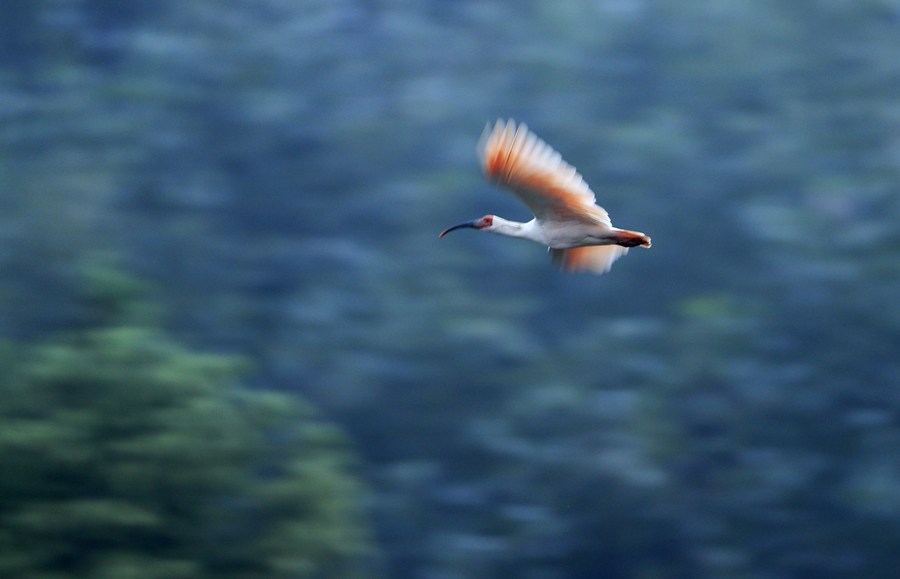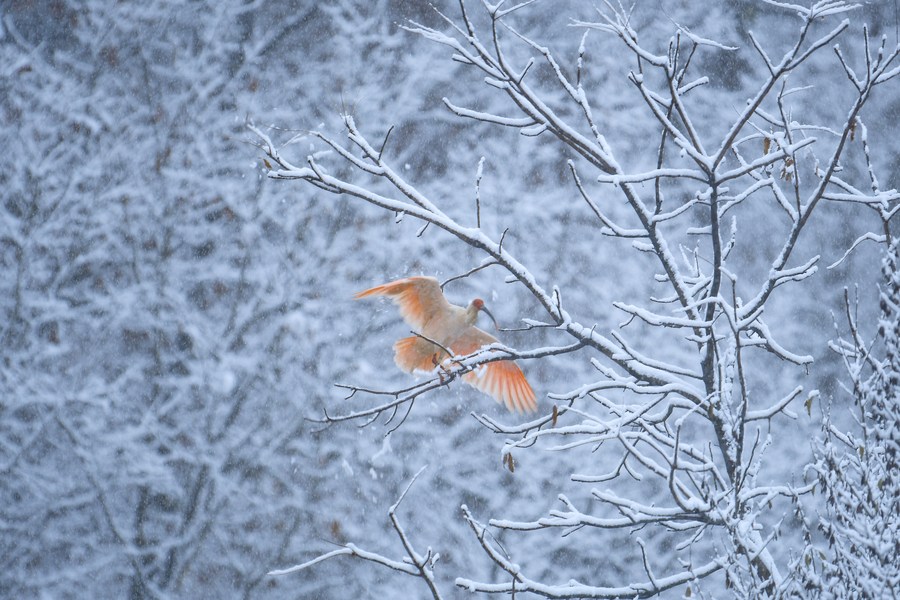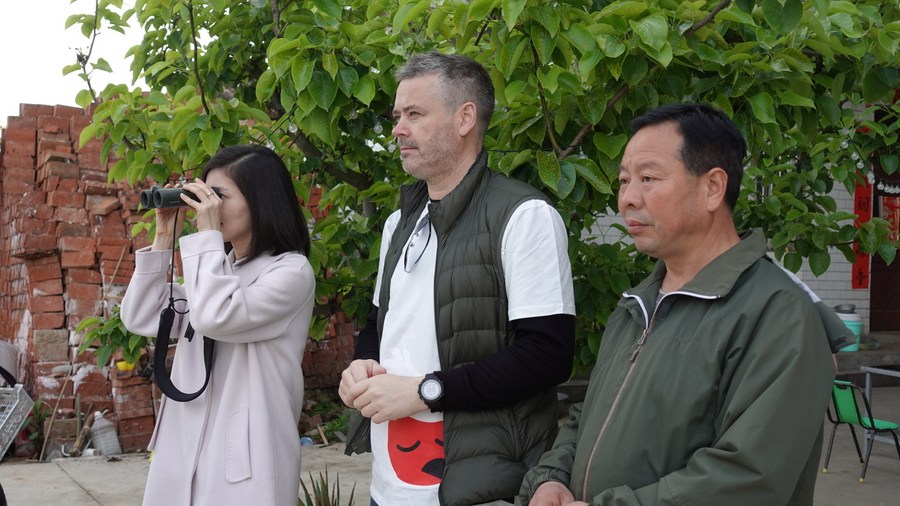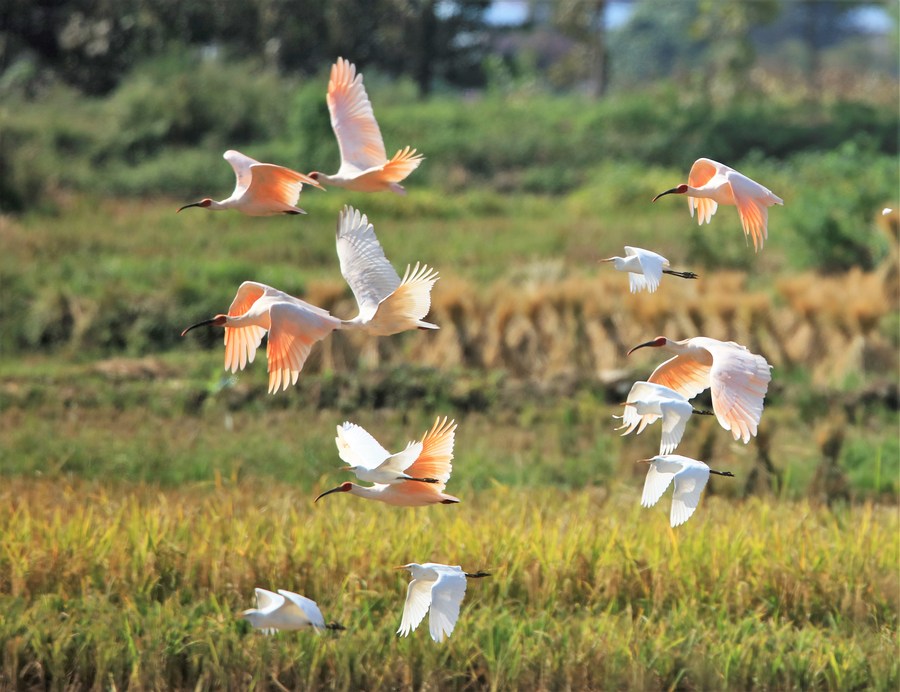-- fourty years ago, chinese ornithologist liu yinzeng rediscovered seven wild crested ibises -- which were thought to be the last remaining specimens in the world -- in the qinling mountains of northwest china's shaanxi province.
-- years of unrelenting efforts have yielded promising results. it is estimated that there are more than 5,000 crested ibises in the world today. yangxian county, where the last seven crested ibises were found, has now turned into an eden of the auspicious bird species.
-- hear what liu and others tell british conservationist terry townshend about the positive and inspiring story of bringing species back from the brink of extinction -- the rediscovery and recovery of the crested ibis.

photo taken on aug. 2, 2020 shows a crested ibis flying in yangxian county, northwest china's shaanxi province. (xinhua/lan hongguang)
british conservationist terry townshend described his return to yangxian county, dubbed the "hometown of the crested ibis," as a great honor, not only because he got to see these majestic birds once again, but because he was able to drop in on a prominent figure whose name has become synonymous with this still endangered species.
sunday marks the 40th anniversary of the rediscovery of the crested ibis.
townshend, with a particular interest in birds, has been living and working in china for over 10 years. invited by xinhua's china chat show, he paid a visit to 85-year-old veteran ornithologist liu yinzeng, widely known and esteemed for his rediscovery of the crested ibis 40 years ago.
"we hear a lot of negative stories about losing species, so it's really important to hear positive stories and to know that species can be saved and brought back from the brink of extinction," townshend said.

british conservationist terry townshend (1st l) and xinhua journalist miao xiaojuan (1st r) talk with liu yinzeng, an ornithologist with the institute of zoology of the chinese academy of sciences at liu's home in northwest china's shaanxi province, april 12, 2021. (xinhua/xu yongzheng)
believed to have existed for over 60 million years, the crested ibis, known as "the oriental gem," is one of the oldest bird species in the world and once flourished in china, the korean peninsula, japan and russia. the bird was designated as an internationally protected bird in 1960.
yet the widespread use of pesticides and fertilizers, hunting and habitat loss due to deforestation brought the birds to the brink of extinction.
the crested ibis was once thought to be extinct, yet its population has undergone a miraculous revival thanks to decades of conservation efforts made by researchers like liu and many local people who believe the bird is auspicious.
the ibis man
kin, japan's last crested ibis born in the wild, died in 2003 at the age of 36, well over 100 in human years.
a figure deeply rooted in japanese history and culture, the crested ibis was first recorded in the "nihon shoki" (chronicles of japan), a history of the nation compiled in the year 720.
when famous japanese environmental journalist and scientist ishi hiroyuki lamented the death of kin in a 2017 article, he also claimed that kin's demise did not mean the extinction of the species.
"the same species of crested ibis was found to still exist in china," hiroyuki wrote. "researchers in china were successfully breeding other wild crested ibises that they had discovered earlier."
liu yinzeng was the man who led a small team that found seven crested ibises, two adult pairs and three fledgelings, in yangxian of northwest china's shaanxi province on may 23 and 30, 1981. they were thought to be the last remaining specimens in the world.

photo taken on jan. 28, 2021 shows two crested ibises by a river in yangxian county, northwest china's shaanxi province. (photo by tao benyao/xinhua)
before their exciting discovery, liu and his colleagues at the institute of zoology, chinese academy of sciences had painstakingly conducted field research for three years, trekking over 50,000 km across china in search of crested ibises. yet their search was in vain.
"at that time, i had prepared my paper concluding that the crested ibis had become extinct," liu recalled.
yet before the survey team formulated their final judgment on the extinction of crested ibises in china, liu requested a field visit to yangxian. his faith paid off, and his new paper was published in 1981 in current zoology, then known as acta zoologica sinica, titled "recovery of japanese crested ibis in qinling range."

photo taken on nov. 23, 2020 shows a crested ibis perching on a tree in snow in yangxian county, northwest china's shaanxi province. (photo by wang ping/xinhua)
"it was an important decision to declare their extinction to the world. if i were to do this all again, i would do the same," liu said. "when it comes to scientific work you must be rigorous, nothing can slip through the cracks."
upon catching sight of the long-beaked, red-faced birds, liu had mixed feelings. he was gratified that their efforts had not been in vain, while at the same time, he felt no relief, instead worrying whether such a tiny population could survive.
the team members safeguarded the birds around the clock, spreading butter on trees and installing protective devices to deal with predators such as snakes.
the promised land
"giant pandas are savage beasts, though they look cuddly," liu said, noting that the proximity of crested ibises to humans makes it possible for the birds and people to keep each other company, thus the protection of this particular species differs from that of other animals.
the locals love the birds. they like to call them "red cranes" instead of crested ibises, believing the color red symbolizes prosperity.
yangxian has turned into an eden of crested ibises. to better protect the species, the local government has introduced bans on hunting in the bird's habitats, cutting down trees where it nests, using chemical fertilizers and pesticides in its foraging areas and firing guns in its breeding areas.

photo taken on june 20, 2020 shows crested ibises foraging in the paddy fields in yangxian county, northwest china's shaanxi province. (photo by xia yongguang/xinhua)
furthermore, protective nets were installed on both sides of a section of track of the xi'an-chengdu high-speed railway in yangxian, to prevent any damage to the birds.
hua ying, president of the yangxian county bird watching association, transformed his front yard into a sanctuary for the crested ibises a few years ago. he has been a volunteer since 1993, promoting knowledge on the protection of the crested ibis in local schools. now he runs a homestay for bird enthusiasts and photographers.
every morning, people can find crested ibises walking through the paddy field in front of hua's homestay.
according to hua, crested ibises are extremely sensitive to their living environment, which means the villagers must ensure they employ organic farming methods, planting crops such as black rice, so as to live in harmony with the local wildlife.

british conservationist terry townshend (c) and xinhua journalist miao xiaojuan (l) observe crested ibises with hua ying, president of yangxian county bird watching association, at hua's courtyard in northwest china's shaanxi province, april 13, 2021. (xinhua/xu yongzheng)
"back in 2003, i proposed to forestry and wildlife protection authorities that the local government should help promote the sales of our pollution-free products," hua said.
he also suggested the county should develop its tourism industry and build facilities like a bird-watching platform to minimize the impact on the crested ibises brought by birders.
"happily all my ideas were adopted," hua said.
a remarkable comeback
china took the rediscovery of the crested ibis seriously and started captive breeding of the birds in 1991.
years of unrelenting efforts have yielded promising results. it is estimated that there are more than 5,000 crested ibises in the world today. the bird's habitat in china has risen from less than 5 square km in 1981 to 15,000 square km today.
there are more than 3,000 crested ibises in yangxian alone, according to liu.
china also donated five crested ibises to help rebuild the species in japan in the 1990s, while japan has been supporting the protection of the crested ibis habitat in china through both governmental and non-governmental projects. the bird has become a bridge of friendship between the two countries.
japan was able to artificially breed more crested ibises from pairs brought over from china. the several hundred birds living today in japan are all descendants of these chinese trailblazers.

undated file photo shows crested ibises flying in the rural area of yangxian county, northwest china's shaanxi province. (photo by zhang yueming/xinhua)
"properly balancing the relationship between species protection and human development is a subject for our long-term exploration in the future," liu said, adding that such work goes beyond the scope of biology and wildlife conservation.
"i have a special connection to the crested ibis, and decided to live with the bird for the rest of my life," said the retired avian expert, who came back to yangxian three years ago and has remained there ever since.
hanging on the wall of liu's living room is a group photo taken in july 2019. in the picture, liu is sitting in the middle of the front row, holding a bouquet of flowers and celebrating his birthday with some 50 crested ibis researchers from around the country.
